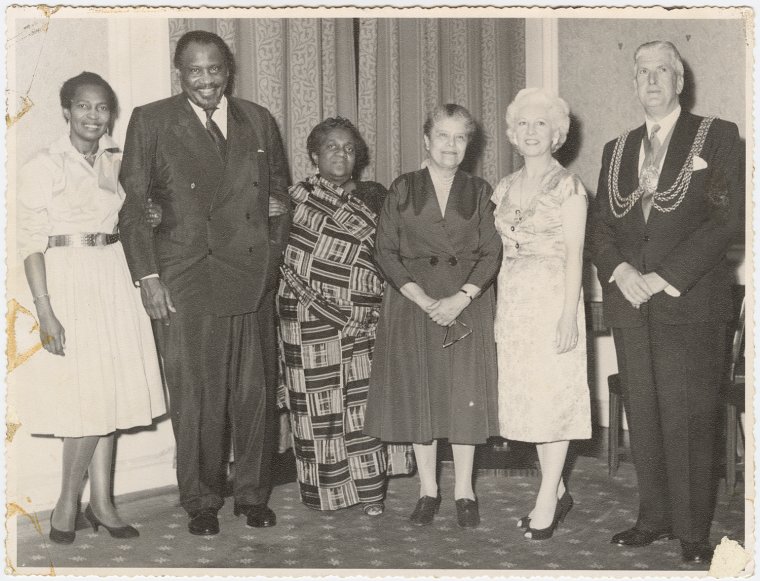Amy Ashwood Garvey (1897-1969) was a Jamaican-born political activist, Pan-Africanist, and the first wife of Marcus Garvey. Her tireless work in championing African liberation and advocating for women’s rights made her a prominent figure in the Pan-African movement.
Early life and education
Amy Ashwood was born on 10 January 1897 in Port Antonio, Jamaica, to Michael Delbert Ashwood and Maudriana Thompson. As a child, Amy was told by her grandmother that she was of Ashanti descent. She was also of Indian descent. Her family moved to Panama when Amy was an infant, where her father worked as a businessman to support the family. In 1904, they returned to Jamaica, and Amy attended Westwood High School for Girls in Trelawny Parish.
While at Westwood High School, Amy Ashwood met Marcus Garvey. The two shared a passion for African American activism and political activities, and they began collaborating on ideas and strategies for the liberation of Jamaica, which was then a British colony.
Founding the Universal Negro Improvement Association (UNIA)
In 1914, Amy Ashwood and Marcus Garvey founded the Universal Negro Improvement Association (UNIA), an organisation aimed at promoting African pride, unity, and self-reliance. The UNIA became Jamaica’s most influential anti-colonial organisation up to 1938, providing women with opportunities to be leaders and influence the public sphere.
At 17, while part of the UNIA, Amy Ashwood wrote romantic letters to Marcus Garvey, stating that their “joint love for Africa and concern for the welfare of their race urged them to immediate action.” She played a significant role in organising the women’s section of the UNIA. She later moved to the United States in 1918, where she worked as Garvey’s aide and as the Secretary of the UNIA’s New York City branch.
Marriage to Marcus Garvey and work in the UNIA
Amy Ashwood and Marcus Garvey became secretly engaged in 1916, but her parents disapproved of the relationship. She returned to Panama that year while Garvey left for the United States. They reunited in New York City in 1918, marking the beginning of Ashwood’s crucial role in developing UNIA branches.
On Christmas Day 1919, Amy Ashwood and Marcus Garvey married in a grand wedding celebration at Liberty Hall, the UNIA building in New York City. After their marriage, Ashwood took on more prominent roles within the UNIA. She became the director of the Black Star Line Shipping Co., established a ladies’ auxiliary of the UNIA, helped plan an industrial school, and aided in founding the UNIA’s newspaper, The Negro World.
In October 1919, Ashwood risked her life to shield Garvey from the bullets of attempted killer George Tyler. Despite her heroism, their marriage began to deteriorate, and they divorced in 1922.
Post-divorce activism and work in Pan-Africanism
After the divorce, Amy Ashwood continued her work as a Pan-Africanist, politician, and cultural feminist in the United States, Jamaica, and England. Amy collaborated with many prominent West Africans, advocating for African independence. She was one of the founders of the Nigerian Progress Union and helped establish the International African Service Bureau (IASB). Ashwood moved to London in 1935, where she founded the Florence Mills Nightclub, a popular gathering place for Black intellectuals.

Organising the 5th Pan-African Congress
In 1945, Amy Ashwood helped organise the 5th Pan-African Congress, which met in Manchester, England. This Congress called for independence from colonial rule, and Ashwood was one of the few women presenters. She spoke about the issues Jamaican women faced and continued to campaign for the liberation of the entire African continent and the rights of African women.
Life in West Africa and return to Jamaica
Ashwood lived in West Africa for three years between 1946 and 1949, where she researched the conditions for women in Nigeria and gave talks to women’s groups. She returned to her native Jamaica and continued her political activism and work promoting women’s rights.
Final years and legacy
Amy Ashwood Garvey’s health began to decline in the late 1960s, and she returned to Jamaica in 1968. She passed away in Kingston on 3 May 1969, at the age of 72. She was buried in Kingston’s Calvary cemetery.
Throughout her life, Amy Ashwood Garvey played a significant role in the Pan-African movement and the fight for women’s rights. Her work in the UNIA, the founding of the Nigerian Progress Union, and her involvement in the 5th Pan-African Congress left a lasting impact on the struggle for African liberation and the empowerment of African women.






Leave a Reply